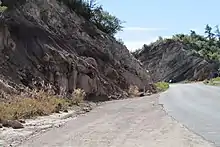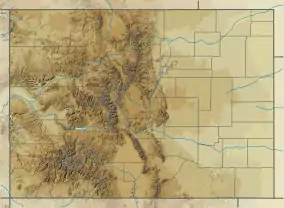Lytle Formation
The Lytle Formation or Lytle Sandstone is a geologic formation found in Wyoming,[2] Colorado,[3] and New Mexico.[4]
| Lytle Formation Lytle Sandstone Stratigraphic range: Early Cretaceous | |
|---|---|
 | |
| Type | Formation/Formation Member |
| Unit of | North-central CO:Dakota Group South-central CO:Purgatoire Formation[1] |
| Underlies | South Platte Formation (at Dinosaur Ridge) Glencairn Formation (valley of the Dry Cimarron) |
| Overlies | Morrison Formation (unconformably) |
| Thickness | 40–120 feet (12–37 m) |
| Lithology | |
| Primary | Sandstone |
| Other | conglomeratic sandstone (notably chert gravel), variegated claystone[1] |
| Location | |
| Coordinates | 38.6025°N 104.867778°W |
| Region | Colorado New Mexico Wyoming |
| Country | United States |
| Type section | |
| Named for | Lytle, Colorado |
| Named by | G.I. Finlay |
| Year defined | 1916 |
 Lytle Formation (the United States)  Lytle Formation (Colorado) | |
Description
The Lytle Formation consists of white to light gray gravels and conglomerates. It is variable in thickness but is about 36 meters (118 ft) at the type location. It is separated from the underlying Morrison Formation by a significant regional unconformity. It is overlain by the South Platte Formation[5] or the Glencairn Formation.[6]
The formation is likely an early Cretaceous geologic unit, with its northern exposure running north and south within the Front Range foothills and the Dakota Hogback in northern Colorado and southern Wyoming where it is assigned formation rank within the Dakota Group.[2] In south-central Colorado, the Lytle is an unassigned formation. The formation is also mapped in the valley of the Dry Cimarron in northeastern New Mexico, where it forms a prominent band in the lower parts of the cliffs.[6]
The Lytle was the last (youngest) non-marine unit to form in the Denver Basin before the region was fully inundated by the Western Interior Seaway. It was formed above sea level from sediments carried by heavily laden rivers flowing from the eroding uplifts of the Sevier orogeny several tens of millions of years before the Rocky Mountains rose. It is particularly noted for abundant brown chert pebbles washed in from the uplifted Permian rock far to the west.[7][1]
Detrital zircon geochronology of the Lytle Formation in the Raton Basin suggests a late Jurassic age for this unit. However, it is possible that the lack of younger zircons reflects a hiatus in deposition of airfall material.[8]
Fossils
Known fossils are fragments of petrified wood eroded from the west as well as nondescript animal burrows, possibly Skolithos and Arenicolites. Body fossils are estremely rare, but a few ostracod and bivalve fossils are consistent with an Aptian to Albian age for the formation.[5]
History of investigation
The formation was first named as the Lytle sandstone member of the Purgatoire Formation by G.I. Finlay in 1916, for exposures near Lytle, Colorado. Finlay found no fossils in the unit, but regarded it as likely early Cretaceous in age.[3] Waage subsequently traced the unit into northeastern New Mexico[4] and northern Colorado.[2]
References
- "Geologic Unit: Lytle". National Geologic Database. Geolex — Unit References. United States Geological Survey. Retrieved 2019-08-30.
- Waage, K.M. (1955). "Dakota group in northern Front Range foothills, Colorado". U.S. Geological Survey Professional Paper. 274-B: B15–B51. Retrieved 2 September 2020.
- Finlay, G.I. (1916). "-Description of the Colorado Springs quadrangle, Colorado" (PDF). U.S. Geological Survey Geologic Atlas of the United States Folio. 203. Retrieved 2 September 2020.
- Waage, Karl M. (1953). "Refractory clay deposits of south-central Colorado". U.S. Geological Survey Bulletin. 993. doi:10.3133/b993.
- Mateer, Niall J. (1987). "The Dakota Group of northeastern New Mexico and southern Colorado" (PDF). New Mexico Geological Society Field Conference Series. 38: 223–236. Retrieved 2 September 2020.
- Ziegler, Kate E.; Ramos, Frank C.; Zimmerer, Matthew J. (2019). "Geology of Northeastern New Mexico, union and Colfax Counties, New Mexico: A Geologic Summary" (PDF). New Mexico Geological Society Field Conference Series. 70 (4): 47–54. Retrieved 1 September 2020.
- Jeremy McCreary. "Colorado Geology Photojournals - A Tribute to Colorado's Physical Past and Present - Colorado Geology Overview". cliffshade. Retrieved 2019-08-30.
- Bartnik, Samantha R.; Hampton, Brian A.; Mack, Greg H. (2019). "U-Pb Detrital Geochronology and Provenance Comparisons from the Nonmarine Strata of the Dakota Group, Lytle Sandstone, and Morrison Formation in Northeastern New Mexico" (PDF). New Mexico Geological Society Field Conference Series. 70: 55–65. Retrieved 19 May 2020.